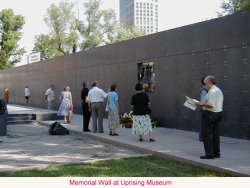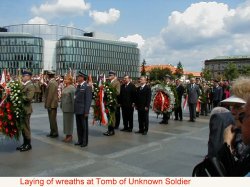
|
Click on any illustration with colored border to see it full size. Then click on "Back" button to return to this page.
At the end of July, 2004, nearly 4,000 surviving veterans of the 1944 Warsaw Uprising against the Nazi occupiers gathered for the first large scale recognition of their struggle. The youngest were in their 70s, a few in their 90s. Some 400 had come from as far away as USA, Australia, Argentina and South Africa for these four emotionally charged days.
At a concert at Insurgents'Square on July 30, the President of Poland, Aleksander Kwasniewski, who was Youth Minister in the last communist government, on live TV professed his personal shame at the treatment of the heroes of the anti-Nazi resistance by the Polish "Peoples' Republic" and the Soviet government. His voice broke and tears appeared in his eyes as he related how thousands had been jailed, executed or died in Siberian labor camps. Previously he had welcomed as his personal guests the last President and several ministers of the anti-communist Polish government-in-exile and the widow of Gen. Władysław Anders, leader of the Polish Second Corps that fought in Egypt, at Tobruk and in Italy alongside the British and Americans, who had been deprived of citizenship by previous communist goverments.
 At 17:00 August 1st. 1944 the young fighters of the Polish Home Army moved out of their hideouts against the superior Nazi forces that had occupied the city for five years. The guns of the Soviet forces driving westward had been clearly audible and Soviet planes had been bombing German positions around the city. For several days Soviet radio stations and dropped leaflets had been calling upon the Poles to rise up and fight. For several days the Germans had been evacuating their civilians and administrative forces from the city and had ordered Poles to report at dawn to dig trenches, an order that had been ignored. The Home Army Commander after consulting with the civilian Underground government and the Polish government-in-exile in London had issued the long awaited order to start the Uprising, in spite of misgivings arising from the arrests by the Soviet NKVD of Polish fighters taking similar actions in eastern Poland.
At 17:00 August 1st. 1944 the young fighters of the Polish Home Army moved out of their hideouts against the superior Nazi forces that had occupied the city for five years. The guns of the Soviet forces driving westward had been clearly audible and Soviet planes had been bombing German positions around the city. For several days Soviet radio stations and dropped leaflets had been calling upon the Poles to rise up and fight. For several days the Germans had been evacuating their civilians and administrative forces from the city and had ordered Poles to report at dawn to dig trenches, an order that had been ignored. The Home Army Commander after consulting with the civilian Underground government and the Polish government-in-exile in London had issued the long awaited order to start the Uprising, in spite of misgivings arising from the arrests by the Soviet NKVD of Polish fighters taking similar actions in eastern Poland.
Although the Polish fighters managed to secure a major part of the city in the first two days and interrupt the German supply routes to the front, they did not have the weapons to withstand the onslaught of German armor and bombers and had to give up ground. The Soviet attack halted and Soviet planes left the skies clear for the Nazis. British, Polish and American planes bringing supplies from southern Italy were refused permission to land on Soviet airfields for refueling. The Polish fighters planned to hold on only for six days, but denied support still managed to resist for an amazing 63 days, finally obtaining recognition by the Germans as a legitimate army under Geneva rules. In the first weeks, all captured prisoners and hundreds of civilians had been murdered by the Nazis.
When, three months later, the Soviets resumed their offensive and quickly occupied Warsaw and the rest of Poland, they systematically arrested members of the Polish anti-Nazi resistance, many of whom were executed or died in Siberian prison camps. The Communist government of Poland continued to harass and arrest members of the Polish Home Army and erased all mention of the Uprising from the history books for the next 45 years.
Now 60 years later, in 2004, the heroic fighters of the Warsaw Rising have finally received full recognition. The president of the city of Warsaw, Lech Kaczynski, deserves full credit for the wonderfully organized 4-day long program and the building of an Uprising Museum which will keep the memory alive for future generations. Fleets of low-level buses provided free transportation for all veterans between the many venues of the observance. Free accommodations were provided in a new hotel for veterans from abroad. Receptions were held on the grounds of the City Hall, the Presidential palace and the Senate. Hundreds of Boy and Girl Scouts circulated at all observances distributing glasses of mineral water and providing assistance to those in need.
At "W" Hour, 17:00, August 1, sirens sounded and all traffic, even metro and light rail trains , halted and everyone observed a two minutes silence. At the Military Cemetery honor guards sounded taps, then fired volleys, at the groups of graves of each of the many Home Army units, such as "Parasol", "Zoska", "Kilinski", "Krybar", "Baszta".
Other moving ceremonies included:
- the dedication by Cardinal Glemp of the new Uprising Museum and the adjacent remembrance wall, on which are inscribed over 5,000 names of fighters killed in action, like the Viet Nam wall at Arlington.
- The evening Mass on August 31 at the Insurgents' Memorial (Krasinski Square) at which Cardinal Glemp officiated, assisted by the Archbishop of the Orthodox Church and the Head of the Polish Lutheran Church, which was followed by an Honor Guard calling out the names of all the individual units that participated in the Rising and the laying of wreaths on the Memorial. Incidentally each of these units had wreath laying ceremonies at their own memorials located at the site of their major battles.
- At the first concert, scouts paraded with torches which had been lit at each of the seventeen major fighting areas and then together lit a huge torch on what looked like the ruins of a building. This flame will remain lit until the 63rd day. At the end of the concert, scouts distributed lighted candles to the participants which they laid around the base of the arch as they left the site. During the concert a clever light show made the 16 story Prudential building appear to be hit by bombs then bursting into flames, like it did in 1944.
- On August 29, members of the Sejm (Parliament) gathered for a special session at which, after standing for minute of silence in memory of the dead they turned and applauded the veterans sitting on the balcony. Afterwards the Marshal of the Sejm presented medals to a number of the veterans. The following day, President Kwasniewski presented more awards at a reception at the Presidential Palace.
On August 1, the traditional noon-time changing of the guard at the Tomb Of The Unknown Soldier was augmented by a parade, and the ceremonial laying of wreaths by representatives of governmental authorities, ambasadors of USA, France, Great Britain and Canada and dozens of Polish Home Army Veteran's Organizations from all over the world.
 An hour later Chancellor Schroeder of Germany laid wreaths at the Wola Cemetery on a mass grave of several hundred civilians murdered by the SS, at the Insurgents' Memorial and at the statue of the Boy Soldier in the Old Town. Then at the closing concert that evening he delivered a speech which was greeted with silence. The only applause came when he pledged that Germany renounced for ever any property or territorial claims against Poland and promised to discourage private German citizens from making any such claims. An hour later Chancellor Schroeder of Germany laid wreaths at the Wola Cemetery on a mass grave of several hundred civilians murdered by the SS, at the Insurgents' Memorial and at the statue of the Boy Soldier in the Old Town. Then at the closing concert that evening he delivered a speech which was greeted with silence. The only applause came when he pledged that Germany renounced for ever any property or territorial claims against Poland and promised to discourage private German citizens from making any such claims.
The Deputy Prime Minister of Great Britain, John Prescott, received warm applause for recognizing Britain's debt to Polish scientists who solved the formula of the German Enigma coding machine, the Polish flyers who fought in the Battle of Britain and soldiers who participated in the battles of Narvik, Tobruk Monte Cassino and Normandy. He ended shouting in Polish: "Za wolność naszą i waszą" (For our and your freedom).
US Secretary of State Colin Powell received warm applause for remarks praising the spirit of Warsaw and promising that never again would Poland be left to fight alone.
The final speaker, Polish historian Władysław Bartoszewski, reminded the crowd that in democracy governments suddenly change and promises "for ever" might not be kept, but that the only guarantee of peace is trust and cooperation between peoples.
Attendance at all ceremonies was limited to veterans who wore sashes with their credentials, and special guests with invitations. Hundreds of ordinary citizens watched the precedings standing quietly behind barriers. All of Warsaw, including all buses, trams, taxis, was decorated with flags, all of the numerous memorials around the city were also covered with flowers. It was reported that many taxi-drivers refused to accept money from crippled veterans. Nature also blessed the four days with glorious sunny weather.
Several thousand Boy and Girl Scouts camped in a park on the right bank of the Vistula river, many coming from other countries, as far away as South Africa and Australia, as well as USA, Ukraine, Lithuania, Latvia and Great Britain.
On Sunday August 1, right after "W" hour, 5p.m., major bookstores opened their doors to the lines waiting to buy the new Polish edition of "Rising '44". The author, Norman Davies, personally autographed copies at the Uprising Museum.
Return to Top of page..
See the Photo page.
|

|
|
See the Photo page.
|
See the most complete documentation in English on the Internet.
Includes eyewitness accounts,
excerpts of message exchanges between Churchill, Roosevelt and Stalin,
photos and fighters' songs.
|
Official Web-site of the
The Uprising Museum
photo galleries - text only in Polish.
|
Read the book
Rising '44: The Battle for Warsaw
by historian Norman Davies.
The first comprehensive history in English of the Warsaw Uprising, the preparations and the betrayal by the Soviets, with many photos and maps.
Support this Web-site, Click title above and order at 32% discount |
| To order a copy of the excellent CNN Program "Warsaw Rising '44" produced by David Ensor, call 1-800-CNN NEWS (1-800-266 6397)
|
| Excellent overall reference to sources of information about
Poland, at University of Buffalo, NY.
|
NOTE!
The background of this page features the
PW symbol in the shape of an anchor that was scratched, painted, chalked on buildings, vehicles, signposts, throughout the five years of occupation. The PW stood for
Polska Walczaca, "Fighting Poland."
PW also represents Powstanie Warszawskie (Warsaw Uprising) and this symbol is now used by all veterans'organizations.
|
|




